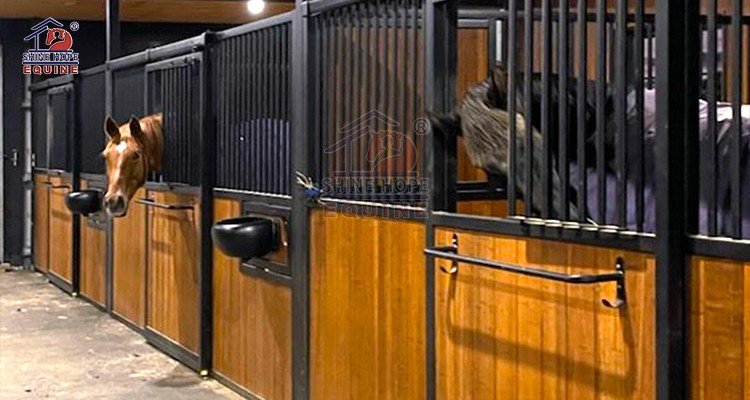When it comes to equine housing, the terms "barn" and "stable" are often used interchangeably, but they refer to distinct structures with unique purposes, designs, and functions. Whether you’re a horse owner searching for "stables close to me" or curious about "what is in a barn," understanding their differences can help you make informed decisions about housing your horses or designing equine facilities. Let’s dive into the key distinctions between these two essential structures.
Barn is a versatile, multi-functional structure primarily designed for storage and livestock housing. Beyond sheltering horses, barns typically store hay, grain, farm equipment, and even vehicles. They often include dedicated spaces like hay rooms, tack rooms, washing areas, and sometimes offices or leisure spaces. Barns are common in commercial operations, such as boarding facilities or equestrian training centers, where they accommodate multiple horses and handle feeding, cleaning, and care on a larger scale. For example, a "dressage barn" might combine stabling with indoor arenas for training.
Stables are more specialized, focusing solely on housing horses in individual stalls. Each stall is designed for a single horse, providing a safe and comfortable space with feeding and watering facilities. Stables are ideal for personal use, such as small farms or private properties, where owners prioritize individual care and training. Unlike barns, basic stables may lack extensive storage areas for hay or equipment, though some include tack rooms or small storage spaces.
Barns are significantly larger, with spacious layouts that include multiple compartments for different functions. They often feature an open upper structure (e.g., loft spaces for hay storage) and may have a classic aisle design with stalls on either side. Types like "cantilever barns" or "ranch barns" use sturdy frames (wood or metal) and offer customizable areas for feeding, grooming, and equipment storage. Modular barns, which are prefabricated, provide flexibility for expansion.
Stables are smaller and more intimate, focusing on individual stalls to prevent horses from interacting aggressively. A "traditional stable" might have stalls with doors leading to paddocks, while "shedrow" designs feature a row of stalls with a shared overhang for shelter. Lightweight or portable stables, popular for events, are made from easy-to-install materials and offer basic protection from the elements. Unlike barns, stables rarely have open lofts or large storage areas unless integrated into a larger barn structure.
Barns are typically found on large farms, ranches, or commercial equestrian facilities ("boarding barns," "equestrian training centers"). Their size and multi-functionality make them suitable for operations that require storing equipment, housing multiple horses, and facilitating group activities like training or competitions. For instance, an "indoor arena barn" combines stabling with a covered training area, ideal for year-round use.
Stables are common on private properties or small farms, catering to individual owners’ needs. Whether it’s a "fox stable" for hunting horses or a "play horse stable" for hobbyists, these structures prioritize simplicity and personal care. Mobile stables are also popular for events or temporary housing, offering convenience for "riding stables" participating in competitions
Barn Types:
Traditional Barns: Classic aisle design with stalls, tack rooms, and feed storage.
Pole Barns: Economical metal or wooden frames, customizable for feeding and storage.
Modular Barns: Prefabricated and adjustable, perfect for flexible layouts.
Indoor Arena Barns: Integrate stabling with covered training spaces.
Stable Types:
Traditional Stables: Individual stalls with paddock access, ideal for privacy and controlled interaction.
Run-in Sheds: Open-sided shelters attached to paddocks, allowing horses to roam freely while offering basic protection.
Lightweight/Portable Stables: Temporary structures for events, made from easy-to-transport materials.
Aspect | Barns | Stables |
Primary Use | Storage, multi-livestock housing, equipment | Dedicated horse housing (individual stalls) |
Size | Large, spacious with multiple compartments | Smaller, focused on individual stalls |
Location | Commercial farms, ranches, equestrian centers | Private properties, small farms |
Storage | Hay, grain, equipment, vehicles | Minimal (tack rooms, small feed storage) |
Design | Open lofts, aisle layouts, customizable | Enclosed stalls, simple ventilation |
Amenities | Grooming areas, offices, arenas | Basic feeding/watering, paddock access |

Whether you need a "cheap barn" for storage or a "prefabricated stable" for personal use, your choice depends on your goals, budget, and the number of horses. Barns are ideal for large-scale operations requiring versatility, while stables offer intimacy and focused care for individual animals. For those searching for "stable suppliers" or "cute barn animals," remember: barns serve as the backbone of farm operations, while stables are the heart of horse-centric housing.
Ultimately, both structures play vital roles in equine care. Whether you’re designing a "medieval stable" for historical reenactments or a modern "horse barn schleich" for play, understanding their differences ensures your horses thrive in a space tailored to their needs.
Shinehope Equine Email us at info@shinehopeequine.com or call +8613869898222.(24 hours).
Looking for more equine housing inspiration? Explore "barn vs shed" debates or discover "stable names" for your next project. Whatever your needs, the right structure will keep your "stable horses" happy and your operations running smoothly!